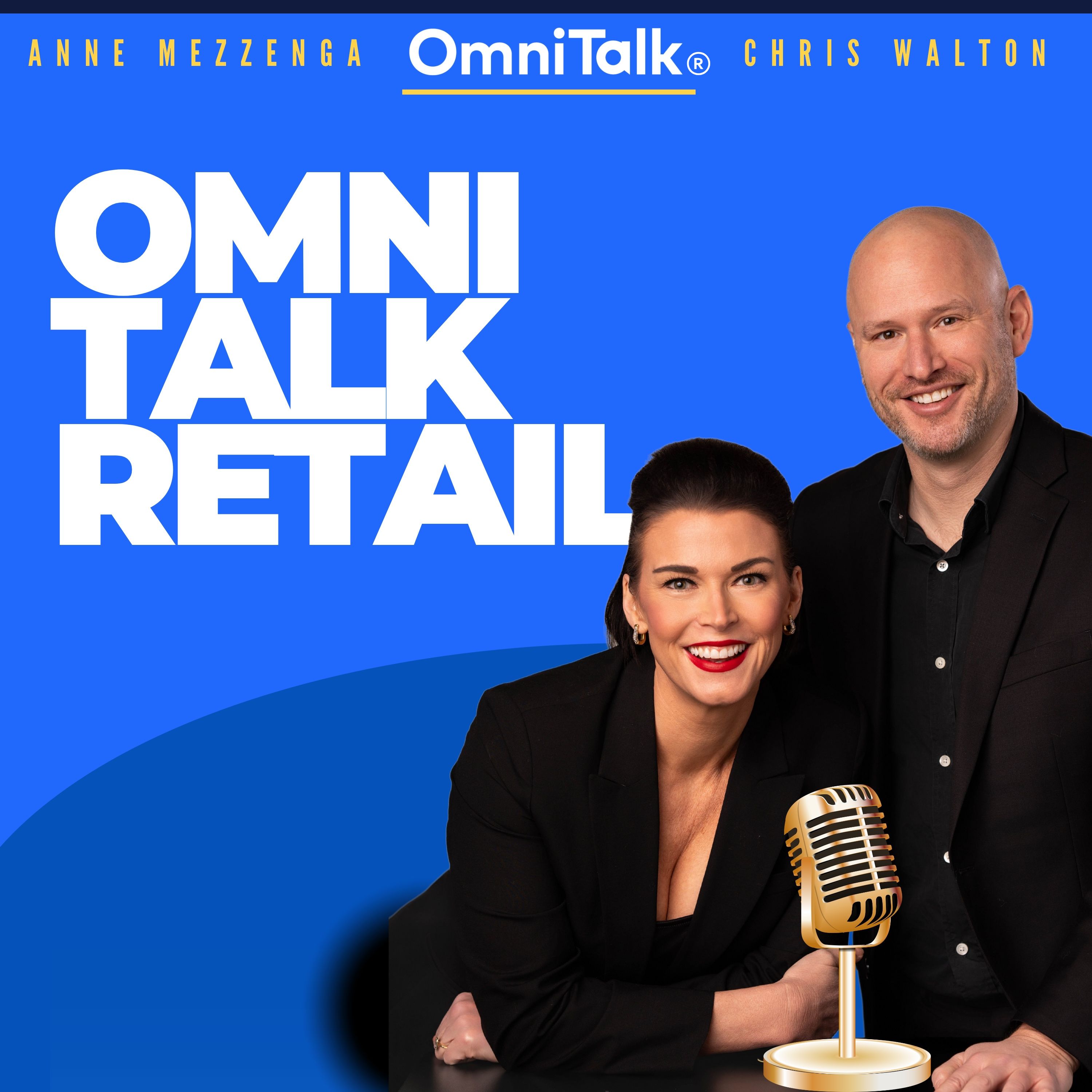Fast Five Shorts | GapVintage: What’s The Verdict?
In the latest edition of Omni Talk’s Retail Fast Five, sponsored by the A&M Consumer and Retail Group, Mirakl, Simbe, Ocampo Capital and Scratch Event DJs Chris Walton and Anne Mezzenga discuss: GapVintage: What’s The Verdict?
For the full episode head here: https://youtu.be/2w2T7EP2Liw
This podcast uses the following third-party services for analysis:
Podcorn - https://podcorn.com/privacy
Transcript
Gap plans to launch seasonal vintage drops throughout the year, according to Retail Dive.
Speaker A:Gap is expanding its partner with Sean Witherspoon, its global vintage curator, to release Gap.
Speaker B:How do you like that job, Chris?
Speaker A:I love when people watch us.
Speaker A:I get comments sometimes from friends are like, I could tell you are smiling as you read that headline that there was something going on in your head.
Speaker A:And that was exactly what I was thinking.
Speaker A:Yes, it's global vintage Curator.
Speaker A:Let's make sure we get that right.
Speaker A:To release Gap Vintage, all one word, I might add, which is a series of curated Gap vintage clothing drops.
Speaker A: l include Gap pieces from the: Speaker A:Gap didn't specify how many drops there would be, but did say they would include seasonal and theme drops.
Speaker A: t the initial drop includes a: Speaker A: It also includes a: Speaker A:Sounds like my style.
Speaker A:And the collection will be available online in the US with an exclusive collection sold in the company's Flatiron store in New York.
Speaker A:Anne, I'm curious.
Speaker B:Yes.
Speaker A:On a scale of 1 to 10.
Speaker B:Yeah.
Speaker A:How much do you like the idea of Gap vintage?
Speaker B:I'm a hopeful seven.
Speaker A:A seven?
Speaker B:Seven.
Speaker B:Yes.
Speaker A:Lucky number seven.
Speaker B:And I'll tell you why.
Speaker B:All right, one vintage Gap is the most in demand Gap product right now.
Speaker B:Like that's what all this next generation is looking to.
Speaker B:They're not going to the Gap store.
Speaker B:They are scouring thrift stores and consignment shops to find this product right now.
Speaker B:So I actually like this more from the perspective of it's a way to Dr.
Speaker B:Traffic.
Speaker B:There's limited drops.
Speaker B:They're doing pop up shops around the globe like they're going into.
Speaker B:And they're doing this on Gap.com, which I think is a smart way to just try to gain interest from a new consumer that hopefully comes for the Gap vintage and stays for maybe some new accompanying Gap pieces like T shirts or some of the other staples.
Speaker B:And I do think that more retailers need to be profiting off the reselling of their product, whether it's vintage product or it's just, you know, the drops or resales that we're seeing, much like what we've described in the past with like Nike and Goat or Stockx.
Speaker B:Like it doesn't make sense that those companies are profiting off of your brand.
Speaker B:But.
Speaker B:And here's the big but, Chris.
Speaker A:There's always a but.
Speaker A:Like we said in the beginning, the.
Speaker B:One person or team with Sean Weatherspoon curating one store and some pop ups, one drop on Gap.com, like, I don't even know from a marketing perspective if that's enough to get the scale that you want to get the success that you would want to bring enough people back to the Gap brand.
Speaker B:I do think it's an idea worth trying, but I think it really depends on what Richard Dixon and the Gap team plan to do for the next phases of this.
Speaker B:Like if it's something they're planning on rolling out, if it's just going to stay the small thing, I unfortunately don't think it's enough to save the Gap.
Speaker B:But you're a seven.
Speaker A:You're a seven with.
Speaker B:I'm a seven with the.
Speaker A:With the caveat.
Speaker A:You're a seven.
Speaker B:Okay, I'm coming down.
Speaker A:Yeah, I think you're coming down.
Speaker B:Maybe I'm like a five.
Speaker B:Maybe.
Speaker B:Maybe.
Speaker A:John, Clear.
Speaker A:Reorient yourself here.
Speaker B:I think so.
Speaker B:But maybe.
Speaker B:I mean, Chris, are you just kicking yourself for not saving all of your vintage Gap anoraks and khakis from the 90s when you were working there?
Speaker B:I mean, you gotta, you could be making.
Speaker A:Nobody wants my resale clothing.
Speaker A:Sure.
Speaker A:That's true.
Speaker B:True.
Speaker B:Where, what's your number though?
Speaker B:Where do you, where do you find?
Speaker A:I'm, I'm, I'm at best the three.
Speaker A:Okay.
Speaker A:I'm like in the two to three range on this.
Speaker A:Marketing wise, I think it's a great hook.
Speaker A:You know, people listen to this stuff, they read about it, people talk about it.
Speaker A:You've seen all the chatter on social media about this too, you know, so, like it's getting buzzed.
Speaker A:So, yeah, nice job on that.
Speaker A:But I think to your point, seasonal drops online in small batches of things you have to source like this, you know, and are on display at one store in New York.
Speaker A:They do nothing.
Speaker A:Numbers.
Speaker B:And some pop ups.
Speaker B:And some pop ups.
Speaker A:Yeah, but I mean, but still, like that does nothing, numbers wise?
Speaker A:Absolutely.
Speaker A:Zero, zilch, nada, like all three of those words.
Speaker A:To say the word nothing.
Speaker A:Like it just nothing comes from it.
Speaker A:So, I mean, until I see something that gets people back in the actual stores in mass, I'm going to remain skeptical of Richard Dixon, even though, you know, he's sure they got the zeitgeist and he's coming to shop Talk.
Speaker A:And I'm sure he's going to be the most watched session at Shop Talk without a doubt.
Speaker A:Because, because even all the points you raised, like the route into resale.
Speaker A:Yeah, I think it's something you can, you can capitalize on.
Speaker A:But that too doesn't stop the bleeding and answer the question of how do you get people into your stores to shop gas gaps regularly priced merchandise, which is what you actually need to survive.
Speaker A:So until I see that, you know, it's, it's, it's just not going to work.
Speaker A:Say nothing of the idea that, like you said, you brought it up 100%.
Speaker A:The idea of scaling and sourcing old vintage clothing is, is an almost impossible idea to scale in of itself.
Speaker A:It's just never going to work in mass.
Speaker A:It's just, it's not physically, you know, economically sustainable as an idea.
Speaker A:So.
Speaker A:So it's just branding, plain and simple.
Speaker A:That's why I'm like, this is like a two or three.
Speaker A:And I still need to see more in terms of how is he enlivening the product itself to get people to pay full price for what is in a Gap store.
Speaker B:Yeah, do.
Speaker B:What do you, I mean, have you changed your thoughts?
Speaker B:I know I've asked you this question in the past, but have you changed your thoughts at all about like, what would be a move that Dixon could make to get people to do that?
Speaker B:Chris, like, do you.
Speaker B:Where, where.
Speaker A:Yeah, it's funny, as you were talking, do.
Speaker A:Yeah, I was thinking about this.
Speaker A:Like, I think if, if this move resonates from a marketing perspective, then I think you have to have a very, you know, deliberate conversation with your product development team, which, you know, I've always been curious if Zach Posen is the guy to get this, but like, okay, what is it that, that the average consumer today, in today's world wants from your clothing?
Speaker A:Like, do you, do you go into logo merchandise a lot more if that's what people are buying, you know, from the vintage collection?
Speaker A:Do you go into the pieces and just kind of update them?
Speaker A:But you have to find some point of position and then of course, you have to stand behind that in the store with the inventory, with the bets, with merchandising to say, hey folks, if you're coming to a Gap store, this is what we want you to buy.
Speaker A:Yeah, I mean, that's what Abercrombie has done fairly well.
Speaker A:They've taken a product position on certain items and they've done really well with them.
Speaker A:And so, you know, fashion, retail is the same thing.
Speaker A:You Got to do that.
Speaker A:And I don't know what that is yet.
Speaker A:They haven't really come out and said what that's going to be.
Speaker A:I need to go into a Gap store again.
Speaker A:It's been like three or four months since I have.
Speaker A:But that's where you, you could potentially take this, right?
Speaker A:You could, but the proof is not there yet for me to say that that's what they're going to do.
Speaker B:So I have, I have a question.
Speaker B:A crazy.
Speaker A:Okay, we're going to skip on this one.
Speaker A:All right.
Speaker B:Maybe we can cut this out if we need to.
Speaker B:But.
Speaker B:So I'm, I'm almost curious, like, it really got me thinking, like this week when we're talking about the de minimis exceptions and Shein and Temu and what that's going to do to the price of their clothing.
Speaker B:I'm almost wondering if Gap couldn't come back a la like American Apparel.
Speaker B:And could you have success in, you know, being a brand that's American made, that's providing quality product again?
Speaker B:Because we also know that that's an important factor for the, the next generation of shopper.
Speaker B:This Gen Z shopper is looking for quality.
Speaker B:Now, price point is a big concern there.
Speaker B:But, but I think, like, I'm wondering if that, like, Gap is an American brand, like, could that help them, like, provide this resurgence of.
Speaker B:We're making products here.
Speaker B:It's good quality product.
Speaker B:We're doing it at the lowest possible price.
Speaker B:The style and then leaning on, you know, like, you're saying, like inspiration from what's selling on vintage Gap or even Zach Posen's inspiration.
Speaker B:But, I mean, do you think that's even a shot that they could take that would help them?
Speaker A:I like where your head is going there.
Speaker A:I think that's just a very difficult proposition for a whole host of reasons, too.
Speaker A:I mean, the business.
Speaker A:I don't know that the business model is set up for that.
Speaker A:You know, in terms of where their source, Gap, has an incredible sourcing arm throughout the world.
Speaker A:Yeah, there'd be an incredible cost increase to doing that.
Speaker A:The problem with Gap, too, is it sits at.
Speaker A:In this, like, kind of nether world in terms of pricing.
Speaker A:It's got Old Navy on one side, it has been on the other.
Speaker A:So then you're probably taking the prices for your average Gap piece of clothing up.
Speaker A:So maybe.
Speaker A:But it would take a long time to get there and there'd be a lot of pain to rewire the operation that way, too.
Speaker A:And at the same time, you mentioned the competitors, the fast fashion competitors, they could come in and undercut you on price for the same goods, you know, comparably, you know, that you're getting sourced in the US And I think, generally speaking, I think for the same item, people still gravitate towards price as much as they want to ring the, hey, made in Americana, made in America thing, you know, Walmart's play that up.
Speaker A:But yet at the same time, it's never like, you know, blown the doors off their business too.
Speaker A:So like, I mean, it's very different.
Speaker A:But I don't know, I just think it would be harder to do than, you know, it probably, you know, seems.
Speaker B:But I just want Gap to survive, Chris.
Speaker A:I just want it to.
Speaker A:The good news is though, there's.
Speaker A:The good news is they could be on, I will say this, they could be onto something if they figure out what it is that their customer wants going forward and how to price it.
Speaker A:Those are two really difficult questions though, for sure, right?
Speaker B:As you said, there's a lot involved in that process.



